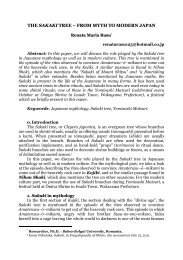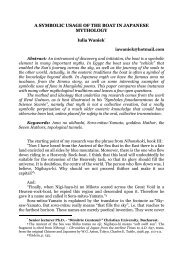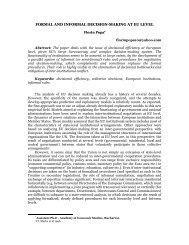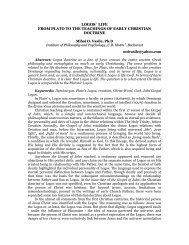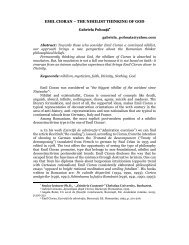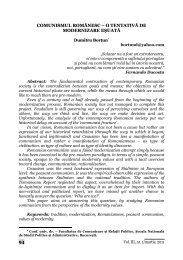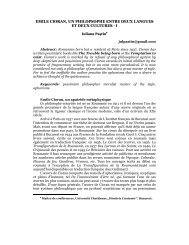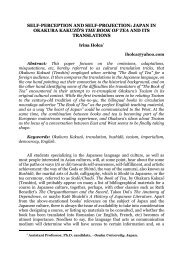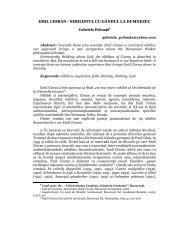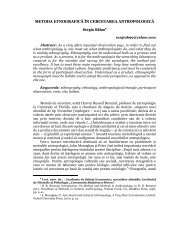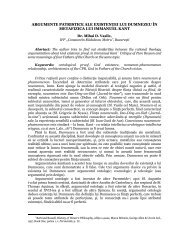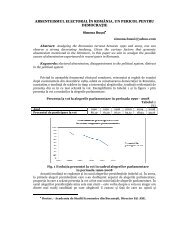JAPANESE TRADITIONAL RAIMENT IN THE CONTEXT OF ... - cogito
JAPANESE TRADITIONAL RAIMENT IN THE CONTEXT OF ... - cogito
JAPANESE TRADITIONAL RAIMENT IN THE CONTEXT OF ... - cogito
Create successful ePaper yourself
Turn your PDF publications into a flip-book with our unique Google optimized e-Paper software.
Japanese textile traditions 1 0 . A number of works are intended to cover the<br />
ornamental diversity of the Japanese costume including the compelling study by<br />
Iwao Nagasaki 1 1 . A special tribute should be paid to the American ethnographer<br />
Liza Dalby whose involved studies have seen a number of editions 1 2 .<br />
Another significant corpus of subject literature includes catalogues of<br />
permanent and itinerary exhibitions and collections of the Japanese costume on<br />
display in various museums worldwide 1 3 . Detailed annotations to the latest<br />
editions as well as a growing number of the costume exhibitions testify for the<br />
broad interest in the kimono both in Japan and beyond 1 4 . Much of our kimono<br />
knowledge is owed to the copyright and brand name holders of the now extinct<br />
large kimono shops as well as reference books and manuals on the types of the<br />
traditional raiment and dressing instructions 1 5 .<br />
The factual materials, however numerous, do not offer an explanation as to<br />
why and how the Japanese costume has evolved the way it has, what were the<br />
driving forces behind its evolution and what are the underlying factors behind its<br />
survival in a much globalized environment. The subject matter of this study is,<br />
therefore, the Japanese traditional raiment in the context of emergent cultural<br />
paradigms.<br />
Such endeavor requires an interdisciplinary approach which necessitates the<br />
application of art analysis, culturological and comparative methods, and involves<br />
diversified sources, among them collections of the Japanese traditional costume,<br />
visual art objects containing ‘costume message’ from state and private museum<br />
collections in Japan, Europe and the USA; literary sources, field study materials<br />
and the researcher’s interviews taken in Japan in 2005-2011 years, as well as<br />
private photographic archives.<br />
І. Costume in Pre-Meiji Japan<br />
І.1. The Evolution of the Traditional Costume: the Natural Body vs<br />
the Social Body. Let us consider, then, the kimono in the diachronic context of<br />
the Japanese culture. As was the case in other cultures, clothing as an ‘exterior<br />
envelopment’ of the body reflects the conception of the bodily and bodily<br />
10<br />
切 畑 健 、 藤 本 恵 子 、 泉 要 次 郎 「 京 の 優 雅 」 京 都 二 〇 〇 五 年 二 四 九 頁 。(Kirihata Ken, Fuji<br />
moto Keiko, Izumi Yodzhiro. The elegance of Kyoto. Kyoto, 2005).<br />
11<br />
. 長 崎 巌 「 着 物 と 模 様 : 日 本 の 形 と 色 」 東 京 一 九 九 九 年 三 三 三 頁 。 (Nagasaki Іwao. Kimono<br />
and patterns (Japanese form and color. Tokyo, 1999).<br />
12<br />
Dalby, L. Kimono: Fashioning Culture. Seattle, 1993.; Dalby, L. Geisha. University of<br />
California Press, 2008.<br />
13<br />
Восток: Искусство быта и Бытия / Государственный Музей Востока. Каталог .<br />
Москва, 2003. (East: The Art of Being and Life. National Museum of the East. Catalogue. Moscow,<br />
2003); Jackson, A. Japanese Textiles in the Victoria and Albert Museum. London, 2000; Fujisawa<br />
Noryo, E. Sano, Y.Woodson, Kawakami Shigeki. Four Centuries of Fashion : Classical Kimono<br />
from the Kyoto National Museum. San Francisco, 1997.<br />
14<br />
Kubota, Itchiku. Opulence: The Kimonos and Robes of Itchiku Kubota. Tokyo, Kodansha<br />
International, 1984.<br />
15<br />
Motoko Ito, Aiko Inoue. Kimono. Higashiosaka, Hoikusha, 1998;<br />
樋 口 清 之 「 装 いの 文 化 」 東 京 一 九 七 三 年 一 二 二 頁 。(Higuchi Kiyoyuki. The culture of the<br />
dressing. Tokyo, 1973); Yamanaka, Norio. The book of kimono. Tokyo etc., 1986. P. 31-131).




